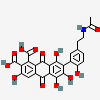On havaittu, että COVID-19 taudissa on fenokonversiotaq aminohappojen ja metabolisten välituotteiden määrissä.
Lisääntynein määrin esiintyviä COVID-19 potilailla ovat:
Glutamic acid, Glutamate eli glutamaatti, glutamiinihappo (E, glu), tämä on excitatorinen aminohappo. Rakenneaminohappo
Quinolinate, kinolinaatti (*), Kinoliinihappo, (QA)
Aspartic acid, aspartate, aspartaatti (D, Asp), Excitatorinen aminohappo, rakenneaminohappo
Phenylalanine, fenylalaniinbi (F, phe), rakenneaminohappo, essentielli
Neopterin, neopteriini
Kynurenine, kynureniini (*) (KYN)
Nicotinic acid, Nikotiinihappo (*) (NA)
5-Hydroxykynurenine, 5 hydroksikynureniini (*), (5-HK)
Alanine, alaniini (A, ala), rakenneaminohappo
Proline, proliini, (P, pro), rakenneaminohappo
Taurine (**) tauriini, ei- rakenneaminohappo, aminosulfonihappo,
Lysine, lysiini, (K, lys), rakenneaminohappo, essentielli
Etanolamine, etanolamiini (EA), seriinin (S, ser) biogeeninen amini
Alfa-amino-butyric acid*), (AABA), alfa-aminovoihappo, cystathioniinin (CSH) kataboliasta homoseriinistä eteenpäin, (biomerkitsijäaine huonosta glukoositoleranssista)
Glutamine, glutamiini , (Q, gln), rakenneaminohappo
Isoleucine, isoleusiini (I, ile), rakennehappo, essentielli.
1-methyl-histidine, 1-metyylihistidiini, 1-Me-His.( telencephalon histidiinimuoto)
Nicotinamide ribosyl (*?)
Glycine, glysiini, (G, gly), rakenneaminohappo, inhibitorinen aminohappo
Ornithine, ornitiini, ORN, ei-rakenneaminohappo, UREA-syklin osa
Leucine, leusiini, (L, leu), rakenneaminohappo, essentielli)
Serine, Seriini (S, ser), rakenneaminohappo,
Tyrosine, tyrosiini, (Y, tyr), rakenneaminohappo, essentielli.
4-OH-proline, 4-hydroxyproline, 4-hydroksiproliini (Hyp), rakenneaminohappo, joka muodostuu posttranslationaalisesti proliinista (P, pro)
Kynurenine acid (KYNA), kynureenihappo (*), neuroprotektiivinen NMDA reseptorin kompetitiivinen antagonisti Gly-kohtaan.
Arginine, Arginiini()R, arg), rakenneaminohappo, UREA-syklin osa
Methionine (**), metioniini, (M, met), rakenneaminohappo, essentielli.
Valine, valiini (V, val), rakenneaminohappo, essentielli.
Kontrolleihin verrattuna vähentynein määrin esiintyviä COVID-19 potilailla ovat:
Histidine, histidiini, (H, his), rakenneaminohappo, toisille essentielli
Tryptophane, tryptofaani (W, trp), rakenneaminohappo, essentielli
Xanthurenic acid, xantureenihappo (*), tryptofaanikataboliasta B6 puutteessa.
Citrulline (Karbamylornithine),, sitrulliini, UREA-syklin jäsen, ei-rakenneaminohappo.
5-OH-anthranilic acid,(5-HANA) 5-hydroksiantraniilihappo (*) tryptofaanikataboliassa kynureenitiessä .
Serotonin, 5-OH-tryptamine, , serotoniini, biogeeninen aminimuoto tryptofaaniaineenvaihdunnasta.
Indole-3-acetic- acid indoli-3-etikkahappo (*), tryptofaanin normaaleja eritysmuotoja.
Picolinic acid, picolinate, pikoliinihappo (*), nikotiinihappoisomeeri tryptofaanin aineenvaihdunnasta.
Asparagine, asparagiini (N, asn), rakenneaminohappo.
Threonine, treoniini, (T, thr), rakenneaminohappo, essentielli.
5-hydroxy-indole-acetic acid, 5-HIAA, 5-OH-indolietikkahappo (*). Normaali erittyvä päätetuote tryptofaanin aineenvaihdunnasta.
NAD, (?*)
Alfa-Amino adipic acid, alpha-aminoadipate, aminoadipiinihappo, lysiinin (K, lys) normaali aineenvaihduntatuote. ei-rakenneaminohappo, dikarboksyylihappo.
5-methyl-histidine, 5-metyylihistidiini, 5-Me-His, telencephalon histidiinejä.
Tryptofaanin aineenvaihduntaan kuuluvia (*)
Rikin (S) aineenvaihduntaan kuuluvia (**)Huom. Virus kiskoo epäorgaanista rikkiä rakentaen Fe/S klustereita viruksen polymeraasikoneiston avuksi. Tästä ilmenee AABA katabolinen rikitön muoto ilmeisesti.
https://www.sciencedirect.com/topics/medicine-and-dentistry/quinolinic-acid
Sitaatti kinoliinihaposta, jonka pitoisuudet on havaittu nousseen COVID_19 taudissa, kuten monen muunkin molekyylin pitoisuus tryptofaanin aineenvaihdunnasta.
QA on 2,3-pyridiinidikarboksyylihappo, jota muodostuu tryptofaanin kataboliassa kynureniinitiessä. Koska tryptofaani, eräs essentielli aminohappo, pystyy menemään aivojen puolelle, pääsee QA täten muodostumaan useissa soluissa, jotka ovat ottaneet tryptofaania ( eli astrosyyteissä, makrofageissa, mikrogliasoluissa ja denriittisoluissa) ja joissa muodostuu kynureniinia.
J.L. McBride, ... J.H. Kordower, in Encyclopedia of Movement Disorders, 2010
Description and Mechanism of Pathogenesis
Quinolinic acid (QA) is a 2,3-pyridine dicarboxylic acid (C7H5NO4). QA is produced following the metabolic breakdown of the amino acid tryptophan, via the kynurenine
pathway. Tryptophan is able to cross the blood–brain barrier (BBB), and
upon entering the brain, is taken up by astrocytes, macrophages, microglia, and dendtritic cells and converted into kynurenine. enzyme,kynureninase, kynurenine is converted to 3-hydroxyanthranilic acid, this is converted into QA through a series of enzymatic( and non-enzymatic)
reactions.
QA is normally present in extremely low, nanomolar
concentrations in the brain and in cerebrospinal fluid
and does not cause damage to the surrounding cells. However, it has
been recently demonstrated that increased levels of QA can be produced
by activated macrophages and microglia in the brain.
Accumulation of
endogenous QA has recently been implicated in the etiology of certain neurodegenerative diseases,
especially those with a strong inflammatory component, such as
Parkinson’s disease (PD), amyotrophic lateral sclerosis (ALS),
Huntington’s disease (HD), Alzheimer’s disease (AD), stroke, multiple sclerosis (MS), and epilepsy.
QA exerts its biological effects by binding to and potentiating Mg2+-sensitive N-methyl-d-aspartate (NMDA) receptors, which normally bind the neurotransmitter, glutamate. As such, QA acts as a glutamate agonist and can potentiate NMDA receptors to the point of excitotoxicity. Specifically, overstimulating this receptor subtype allows high levels of calcium ions (Ca2+) to enter the cell, activating enzymes such as endonucleases, phospholipases, and proteases. These enzymes can then go on to damage cellular structures such as components of the cytoskeleton, membrane, and DNA and ultimately cause cell death. QA administration induces both apoptotic and necrotic types of neurodegeneration.
In addition to a loss of neurons, QA administration also leads to a
robust increase in the number of astrocytes (astrocytosis) and reactive
microglia (microgliosis) in the region of the lesion.
HARPER:haen esiin vanhan kirjani ja katson miten kynureenitie menee.
Tryptophan ( essentielli aminohappo, rakenneaminohappo, ravinnossa saatava, W, trp)
Aromatic aminoacid decarboxylase: tryptamine ( biog. amine)
Tryptophan pyrrolase, O2, Fe++: N-Formylkynurenine
(immuneactivation)
N-Formylkynurenine + H2O : Kynurenine (KYN) ( stress substance) and +HCOOH
B6 Deficienbcy: Xanthurenic acid ( unnormal metabolism)
Kynurenine-> Kynurenic acid (KYNA) and alfa-KG+ (NH3) . KYNA is neuroprotective and NMDAR antagonist in Gly site.
Kynurenine + O2 + NADPH -> 3-OH-kynurenine (3-HK)
3-HK + Kynureninase + B6-PO4 -> 3-OH-antranilate (3-HANA) and alanine
2-HANA + O2, -SH required -> alfa-amino-beta-carboxymuconic acid semialdehyde
a)
alfa-amino-beta-carboxymuconic acid semialdehyde
(rapidly decarboxylated to alfa-amino-muconic semialdehyde , then
1) ( in liver, B6, enzymatically) ->alfa-hydroxy- muconic acid semialdehyde
2) NAD+ ->>alfa-oxalocrotonate and NADH+H2
3) NADH+H+->> alfa-ketoadipate and NAD+
4) CoASH, NAD+ ->> Glutaryl-CoA and CO2 and NADH+H+
5) CoASH -> 2 Acetyl-SCoA and CO2.
b)
alfa-amino-beta-carboxymuconic acid semialdehyde
Spontaneous non-enzymatic ring closure, neurotoxic pathway (chorea Huntington type)
-> Quinolinate (QA or QUINA) and H2O
QA - CO2 ( decarboxylation) -> Nicotinic acid (NA)
c) Also enzymatic pathway in Liver; B6 vitamin required.
From alfa-amino-beta-carboxymuconic acid semialdehyde
alfa-picolinate, isomere of nicotinic acid


